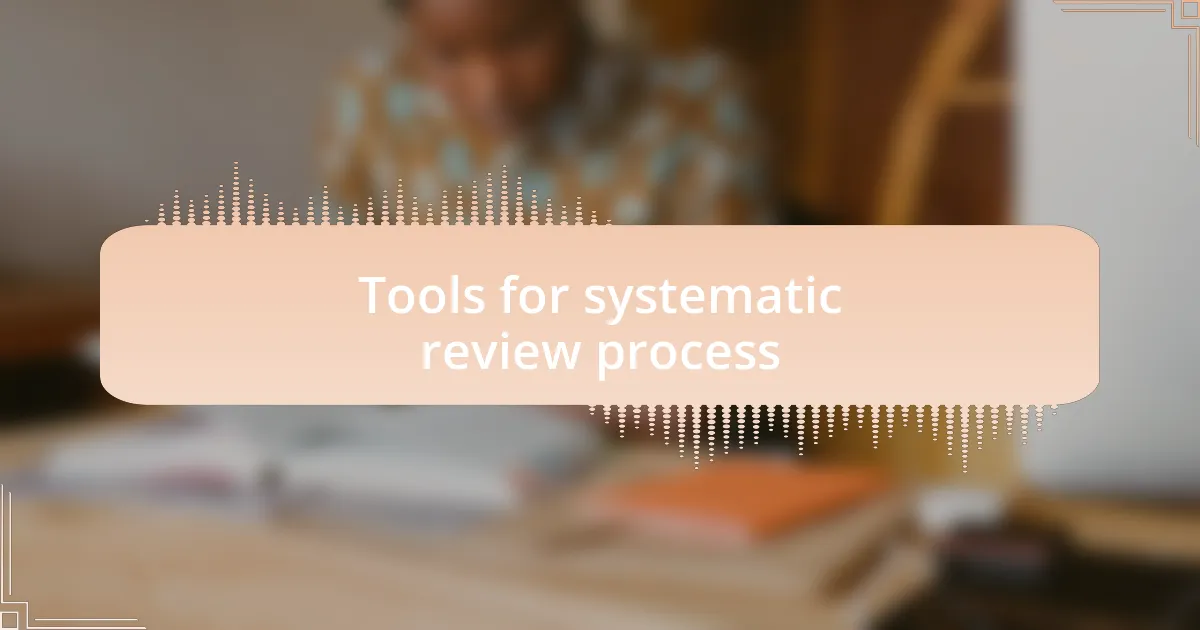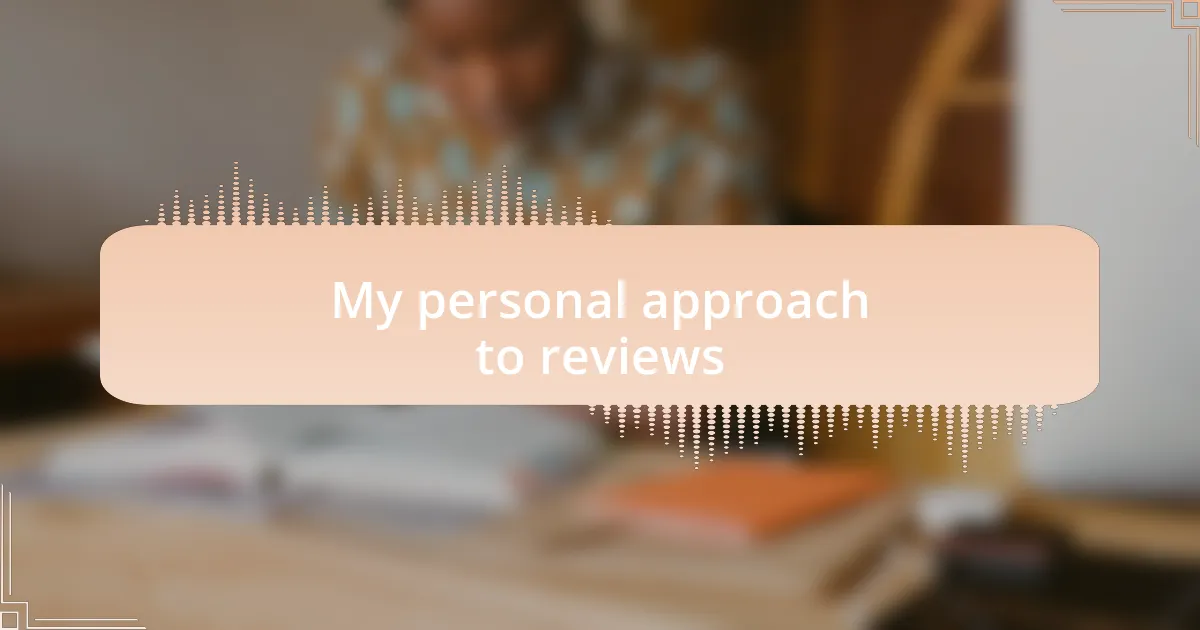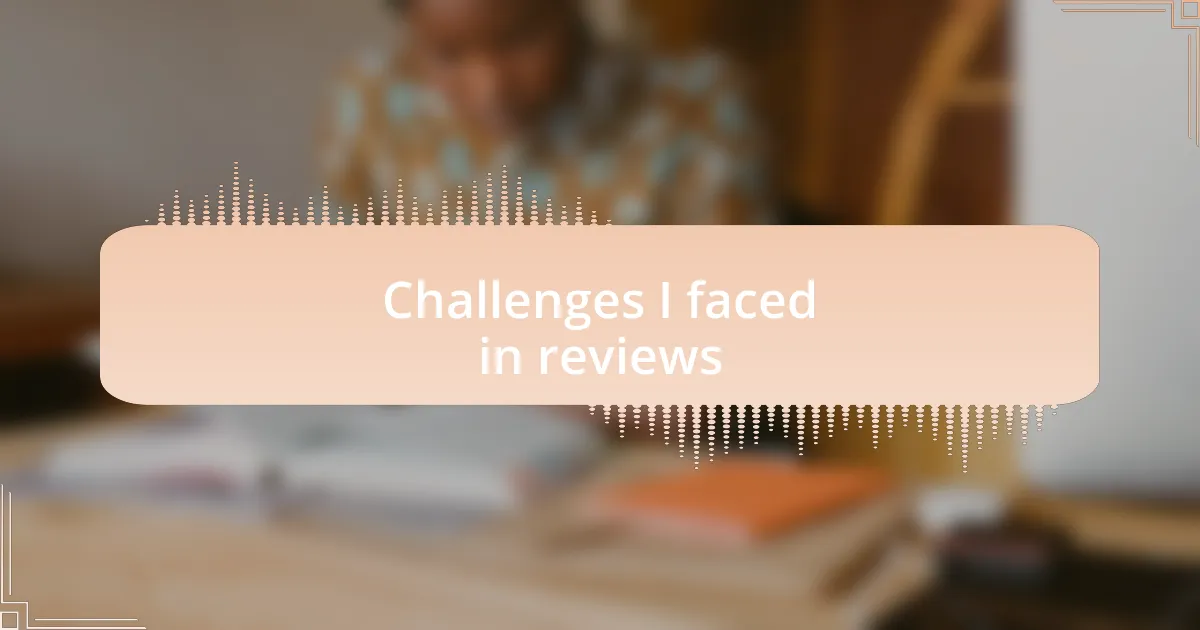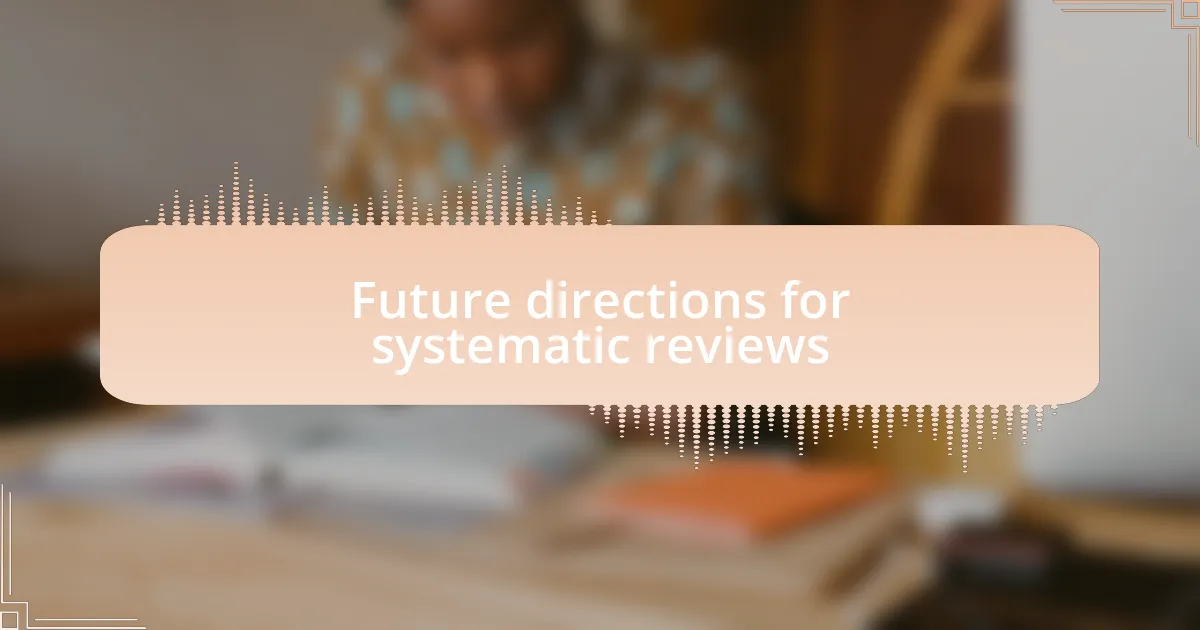Key takeaways:
- Systematic reviews offer a rigorous methodology for synthesizing research, providing clarity and guiding evidence-based practices in clinical settings.
- These reviews identify gaps in knowledge, supporting future research and informing policy decisions to improve patient care.
- Utilizing tools like RevMan, EndNote, and NVivo can significantly enhance the efficiency and quality of the systematic review process.
- The future of systematic reviews is likely to involve greater use of technology and collaboration, emphasizing transparency and reproducibility in research practices.

Understanding systematic reviews
Systematic reviews are often viewed as the gold standard in research synthesis, but what does that really mean? They compile and analyze data from multiple studies to provide a comprehensive overview of a specific topic. I recall my first encounter with a systematic review during my training; the way it meticulously pulled together findings left me in awe of how organized and clear-cut the process can be.
What sets systematic reviews apart is their rigorous methodology. They follow a defined protocol, including specifying research questions, selecting studies with clear criteria, and systematically extracting data. I remember grappling with these roles at first, but understanding how each component contributes to the integrity of the review opened my eyes to its importance.
A systematic review is not just a summary of articles; it’s an in-depth exploration that can reveal trends, gaps, and inconsistencies in the existing literature. This insight can be pivotal in guiding evidence-based practices! Reflecting on my experiences, I often find myself asking: how can we expect to make informed decisions in clinical practice without the clarity that systematic reviews provide?

Importance of systematic reviews
Systematic reviews play a crucial role in bridging the gap between research and clinical practice. I vividly remember the feeling of confusion I had when trying to sift through numerous studies on a topic. A well-conducted systematic review not only brought clarity but also equipped me with the confidence to make decisions based on solid evidence. It was like finally finding a roadmap in an area where I felt lost.
Moreover, these reviews create a foundation for future research by identifying gaps in current knowledge. During my training, I encountered a systematic review that highlighted a critical deficiency in understanding a specific intervention’s effectiveness. It struck me how these findings can propel the field forward by pointing researchers toward unexplored avenues. Have you ever considered how these insights could reshape our understanding of patient care?
Finally, the importance of systematic reviews extends to influencing policy and guidelines in clinical settings. I recall a discussion with colleagues about how certain guidelines were informed by comprehensive reviews. It really made me appreciate the impact such analyses have on shaping best practices and improving patient outcomes. Without them, decisions could easily be based on outdated or incomplete information.

Tools for systematic review process
When it comes to conducting systematic reviews, familiarity with the right tools can immensely ease the process. In my experience, software like RevMan has proven invaluable. It provides a user-friendly platform for data analysis and helps in managing references effectively. Have you ever faced the daunting task of keeping track of hundreds of sources? A dedicated tool can make all the difference in keeping your workflow organized.
Another essential tool to consider is EndNote, which I found particularly useful for managing citations. I remember feeling overwhelmed by the number of articles I needed to reference. EndNote allowed me to sort, annotate, and import citations seamlessly. This streamlined my reviewing process significantly, freeing me up to focus on synthesizing the data rather than getting lost in citation complexities.
For qualitative analysis, I often turn to NVivo. This software helps in coding qualitative data and helps in visualizing patterns and themes that emerge from literature. The first time I used it, I was amazed to see how easily it transformed unstructured data into coherent insights. Have you ever wished you had a clearer view of the bigger picture? NVivo provides that clarity, making it easier to draw meaningful conclusions from qualitative studies, which can sometimes feel like piecing together a puzzle without a clear image.

My personal approach to reviews
My approach to reviews is heavily influenced by my desire for thoroughness and clarity. I often start by outlining key questions that guide my research. This strategy has saved me countless hours of wandering through literature without a clear purpose. Have you ever felt lost in a sea of articles? Crafting specific questions gives me a roadmap to follow, ensuring that I remain focused on the relevant aspects.
I also emphasize the importance of collaboration. Sharing my findings and thoughts with colleagues not only enhances my understanding but also opens my eyes to different perspectives. There was a time when I conducted a review solo, and while I felt in control, I realized how much richer my conclusions could have been had I engaged with others. This insight made me appreciate that two heads are better than one, especially in navigating complex topics.
After I compile the data, I take a step back to reflect on the implications of my findings. This reflective phase is crucial, as it allows me to connect the dots and formulate a narrative that is both coherent and impactful. I often ask myself: What does this mean for clinical practice? This question drives my analysis and ultimately shapes how I present my results, making them more relevant and valuable.

Challenges I faced in reviews
Gathering and assessing data in a systematic review can often feel overwhelming. I remember one particularly challenging review where I sifted through hundreds of articles, only to find that many didn’t meet my inclusion criteria. It was frustrating to see so much effort go to waste, raising the question: How do you stay motivated when faced with such hurdles? For me, taking a step back to recalibrate my focus proved essential, allowing me to redefine my parameters and streamline my search effectively.
Another challenge I’ve encountered is reconciling conflicting results from different studies. In one instance, I found two studies on the same intervention yielding opposite conclusions. This contradiction left me puzzled and questioned my own understanding of the topic. How do you navigate these choppy waters? I learned that carefully analyzing study methodologies and considering the context of each research finding can help untangle these discrepancies, leading to clearer insights.
Time management is another critical aspect that constantly tests my resolve during these reviews. Juggling multiple reviews with tight deadlines can create a sense of pressure that weighs heavily on me. I vividly recall a time when I underestimated the time needed for a thorough synthesis of findings and ended up working late nights to meet my deadline. Have you ever felt that crunch? I’ve adopted a more disciplined approach now, breaking tasks into manageable segments to ensure I stay on track without the last-minute stress.

Future directions for systematic reviews
The future of systematic reviews is exciting, particularly with the rise of technology and AI. I once attended a conference where a researcher showcased a tool that could rapidly analyze vast quantities of literature in mere minutes. Imagine cutting down the weeks we typically spend sifting through resources! As I pondered this, I thought about how technology could transform our approach, essentially creating a more efficient pathway to uncovering key insights.
Looking ahead, I can’t help but wonder how collaborative platforms will shape systematic reviews. Recently, I collaborated with colleagues across different institutions on a review, and it was a game-changer. The diverse perspectives enriched our analysis and led to more comprehensive conclusions. Could the future involve teams from across the globe working in real-time, sharing ideas and frameworks? I truly believe that harnessing a collective intelligence could not only speed up the process but also enhance the quality of our analyses.
Moreover, addressing the evolving standards of transparency and reproducibility in reviews is crucial. With the push for open science, I’ve noticed a shift in how we document our methods and findings. Reflecting on my own experiences, it often felt daunting to lay bare the details of my process. However, embracing this transparency can build trust in our findings. How can we move forward effectively in this regard? I believe that fostering an open dialogue about our methodologies will be essential for future contributions to the field.